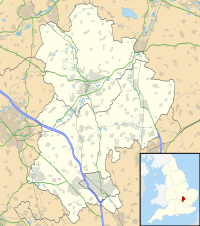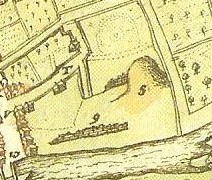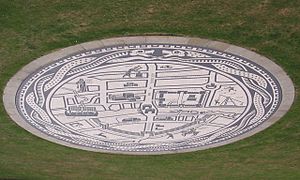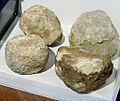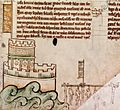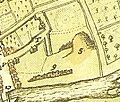Bedford Castle facts for kids
Quick facts for kids Bedford Castle |
|
|---|---|
| Bedford, Bedfordshire, England | |
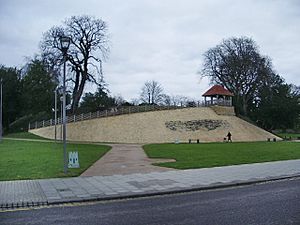
Remaining motte of Bedford Castle
|
|
| Coordinates | 52°08′07″N 0°27′48″W / 52.13539°N 0.46333°W |
| Type | Motte and bailey |
| Site information | |
| Condition | Destroyed, part of motte remains |
| Site history | |
| Materials | Stone |
Bedford Castle was a huge medieval castle located in Bedford, England. King Henry I likely built it after 1100. This castle played a big part in two major conflicts: the Anarchy, a civil war, and the First Barons' War.
The castle was made much stronger with stone additions over time. However, its exact layout isn't fully known today. In 1224, Henry III of England attacked the castle. This happened after a disagreement with a powerful leader named Falkes de Breauté. The attack lasted eight weeks and involved a large army of up to 2,700 soldiers. After the castle gave up, the king ordered it to be torn down.
Even though parts were rebuilt during the English Civil War in the 1600s, the castle mostly stayed in ruins. In the 1800s, Bedford grew, and houses were built over much of the old castle site. Today, only a part of the original castle mound, called a motte, remains. This area is now an archaeological park, created between 2007 and 2009.
Contents
The Story of Bedford Castle
Building the Castle (1100–1153)
Bedford Castle was probably built by King Henry I after 1100. It was located in the town of Bedford, looking over the River Great Ouse. The castle was built right inside the town. Many old Anglo-Saxon streets had to be removed or moved. This changed the town's street layout forever.
The castle was first built as a motte and bailey design. This means it had a large earth mound (the motte) with a tower on top. It also had a walled area (the bailey) next to it. At first, it was likely much smaller, just the motte and an inner bailey.
Who Controlled the Castle?
By the early 1100s, a royal officer called a castellan controlled the castle. This was Simon de Beauchamp. His father, Hugh de Beauchamp, had helped conquer England in 1066. People at the time described the castle as very strong. It had a huge earth bank and ditch, a tall, strong wall, and a very solid tower.
Simon died in 1137. King Stephen agreed that Simon's daughter should marry Hugh the Pauper. The castle was supposed to go to Hugh. But Miles and Payn de Beauchamp, Simon's nephews, said the castle belonged to Miles. They refused to give it to Hugh.
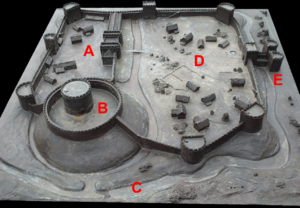
The Anarchy and Bedford Castle
Around this time, a civil war started in England. This war was between King Stephen and the Empress Matilda. It was a very confusing time known as the Anarchy. Matilda's uncle, David I of Scotland, invaded England in 1137 to support her.
Miles de Beauchamp said he supported King Stephen. But Stephen decided to take Bedford Castle before going north. Stephen gathered an army to attack the castle. Miles, however, knew about the attack beforehand. He brought in lots of supplies, getting ready for a long fight.
Stephen couldn't capture the castle quickly. So, he left a force under Hugh to try and starve the castle into giving up. Stephen then marched north to deal with the Scottish invasion.
A Peace Deal and Recapture
Henry of Blois, the Bishop of Winchester, tried to make peace. He reached an agreement, and after five weeks, the castle finally surrendered. The soldiers inside were allowed to leave safely. The castle was given to the king.
However, the deal seemed to let the Beauchamps keep the lands around the castle. In 1141, Miles returned and took the castle back. We don't know exactly how he did this.
Miles then supported the Empress Matilda. In 1146, Ranulf, the Earl of Chester, who was sometimes on the king's side, attacked Bedford town. He captured the town but couldn't take the castle. Miles kept control of the castle until he died a few years later.
Towards the end of the war, Bedford Castle might have been attacked again. In 1153, Henry II marched through Bedford. Records show damage to the town at this time. Historians are not sure if the castle was attacked then too.
Expanding the Castle (1153–1224)
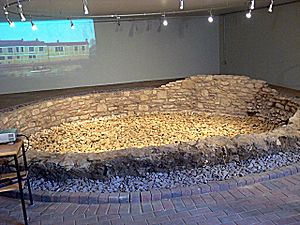
In early 1215, tensions grew between King John and some of his barons. This led to the First Barons' War. The rebel barons tried to attack Northampton Castle but failed. They then went to Bedford Castle, but it held strong, so they moved on to London.
At this time, William de Beauchamp held Bedford Castle. But he rebelled against King John. Falkes de Breauté, a loyal leader, fought back and took Bedford Castle for John in 1216. In return, John gave Falkes the "Honour of Bedford," which meant he controlled the castle and its lands.
As the war continued, Falkes gained control of other castles like Plympton and Carisbrooke. He also kept Bedford. After King John died in 1216, the war turned. Falkes and others helped restore John's young son, Henry III, to power.
Falkes' Big Changes
After the war, Falkes made Bedford Castle his main base. He made it much bigger and stronger. He even tore down nearby churches, St Paul's and St Cuthbert's, to make space. He reused their stones for the castle.
The exact shape of the castle after Falkes' changes is still a bit of a mystery. It seemed to be a square shape. It had a new barbican (a fortified gatehouse). There was an outer and an inner bailey. The inner bailey was in the southeast corner. It was protected by a ditch and a stone-lined fence. Other stone-lined ditches were around the castle. A new keep (main tower) was built on the motte.
Historians think the new keep was probably a "shell keep." This is a circular wall built on top of a motte, with buildings inside. The stone-lined fences and ditches at Bedford were very unusual for England. The castle also had a secret watergate facing the river. There was a large hall inside the inner bailey. It was at least 13 meters (43 feet) wide and 40 meters (131 feet) long. There might have been a big stone gatehouse on the outer bailey wall. A mound in the northeast corner probably held a large tower.
The Great Attack of 1224
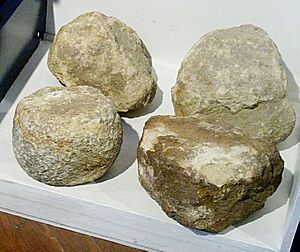
King Henry III decided that Bedford Castle should go back to its original owner, William de Beauchamp. Henry was very annoyed that Falkes refused to give it up. Things got worse when Falkes' men captured Henry of Braybrooke, a royal judge. This judge was hearing cases against Falkes.
When Falkes refused to free the judge, Henry gathered an army. He had support from the Church, including Stephen Langton, the Archbishop of Canterbury. Henry marched to Bedford. Falkes had left the castle in charge of his brother, William de Breauté, and about eighty men. William refused to surrender to the king. Falkes probably hoped the castle would hold out long enough for Pope Honorius III to step in and help him. The Archbishop officially removed William from the Church, and the attack began.
A Massive Siege Effort
Attacking Bedford Castle needed huge amounts of supplies. Siege engines were brought from Lincoln, Northampton, and Oxfordshire. Carpenters built more on site using wood from Northamptonshire. Ropes came from London, Cambridge, and Southampton. Hides came from Northampton, and tallow (animal fat) from London.
Workers were gathered from across Bedfordshire and Northamptonshire. Miners came from Hereford and the Forest of Dean. Crossbow bolts were ordered from a storage place at Corfe Castle. In total, 43,300 crossbow bolts were ordered by the king. Local trees were cut down, and stone was dug up to use as ammunition for the siege engines. Tents and fancy foods for the King were sent from London.
Henry's total cost for the attack was £1,311. We don't know exactly how many soldiers Henry had. But there might have been between 1,600 and 2,700 men there at any time. To help pay for the attack, Archbishop Langton told his bishops to send one man for every 24 hectares (60 acres) of land they owned. He also put a special tax on church lands.

How the Castle Fell
Henry set up many siege engines around the castle. One probable trebuchet (a large catapult) and two mangonels (another type of catapult) were on the east side. Two mangonels were on the west side, aiming at the main tower. One mangonel was on both the north and south sides. Two "siege-castles" (tall wooden towers) were built to watch the people inside the castle.
William de Breauté was confident. He thought his brother would return to help, or the Pope would step in. So, he held on despite the attacks. But the royal army started to lose many men. One writer, Ralph of Coggeshall, said that seven knights and over 200 soldiers and workers were killed.
Bedford Castle finally fell after four main attacks. First, the royal forces captured the barbican. Then, they stormed the outer bailey. They took most of the castle's supplies but lost many of their own men. Miners, protected by a "cat" (a movable shelter), dug under the walls. They made part of the wall collapse, getting into the inner bailey.
Finally, on August 14, the miners attacked the main tower itself. They lit a fire under the walls. This cracked the stone and filled the building with smoke. The women of the castle, including Falkes' wife, and Henry de Braybrooke were released. The king's flag was raised over the tower. The next day, William and his soldiers surrendered.
After the Surrender
There was a discussion about what to do with the captured soldiers. Accounts from the time suggest the prisoners asked the Archbishop for help, but he refused. Henry then had all the male soldiers hanged. Only three knights were spared because they agreed to join the Knights Templar, a religious military group.
Three days after Bedford Castle fell, the Pope sent a letter. He demanded that Henry stop his fight against Falkes. But it was too late. Alexander de Stavenby, the Bishop of Coventry, convinced Falkes to surrender after the castle fell. Falkes gave up his remaining castles and was forgiven by Langton. He then went into exile.
Historian R. Brown noted that the 1224 attack on Bedford Castle was amazing. The castle's soldiers held out against "the concentrated military resources of the whole kingdom" for eight weeks. Historian David Carpenter believes the fall of Bedford Castle showed that the king's central government was now in control over powerful local barons.
Later Years (13th–19th Centuries)
After the attack, King Henry III ordered the castle to be taken apart. Workers filled in the ditches and cut the stone walls in half. William de Beauchamp was not allowed to rebuild the castle. Instead, he built an unfortified house in the inner bailey.
St Paul's and St Cuthbert's churches were rebuilt in 1224 using stone from the castle. The sudden availability of cheap stone also led to many of Bedford's streets being repaved in 1224. Local stories say that the first stone bridge in Bedford, the Great Bridge, was built using stone from the castle.
By 1361, the castle site was described as "an empty plot of old enclosed by walls." It seems to have been abandoned for most of the medieval period. The old-history expert John Leland visited the site in the 1500s. He wrote that the castle was "now clean down" (completely destroyed). The mapmaker John Speed made a map of Bedford in 1611. It showed the motte and a small piece of the bailey wall still standing on an otherwise empty site.
The English Civil War
When the English Civil War started, Bedford supported Parliament. Prince Rupert of the Rhine temporarily captured the town in 1643. The castle was then made stronger again for the war. A wooden fort and prison were likely built on the remains of the motte. A hundred soldiers defended it.
After the war, the motte was used as a bowling green until the 1800s. In 1804, the castle's northeast tower was turned into a hexagonal building. This was for the local militia (a citizen army). Bedford began to grow eastward in the late 1800s. The castle baileys became popular places for building houses. In 1851, the last parts of the barbican were destroyed to build cottages.
Bedford Castle Today (20th–21st Centuries)
Today, only the base of the motte remains at Bedford Castle. It is 7.5 meters (25 feet) high and 49 meters (161 feet) wide at the top. It is a protected historical site. Archaeologists have done work to learn more about the castle's history. However, digging is hard because the site is in the middle of a town.
Digs between 1969 and 1972 helped show the general shape of the castle. More work was done in 1995–96 and again in 2007. After the 2007 investigations, an archaeological park was built on part of the castle site. This happened between 2007 and 2009. The park is now part of a development with restaurants and apartments. The park includes one of the castle's lime kilns, found in 1973. It also shows the foundations of a hall discovered at the castle.
In 2004, Bedford Borough Council asked artist Gary Drostle to create a mosaic map of Bedford. This map shows the castle and Bedford's medieval history. It is placed in front of the castle mound.
Images for kids
-
A reconstruction of how Bedford Castle may possibly have appeared in 1224; A – inner bailey; B – keep; C – moat, fed by the River Great Ouse; D – outer bailey; E – gatehouse
-
The medieval lime kiln preserved as part of the archaeological park at Bedford Castle
-
Mangonel shot, discovered at the castle in the 1970s and probably dating from the 1224 siege
-
A near-contemporary sketch by Matthew Paris of the keep and tower of Bedford Castle (l) during the 1224 siege, and the execution of the garrison after their surrender (r)


